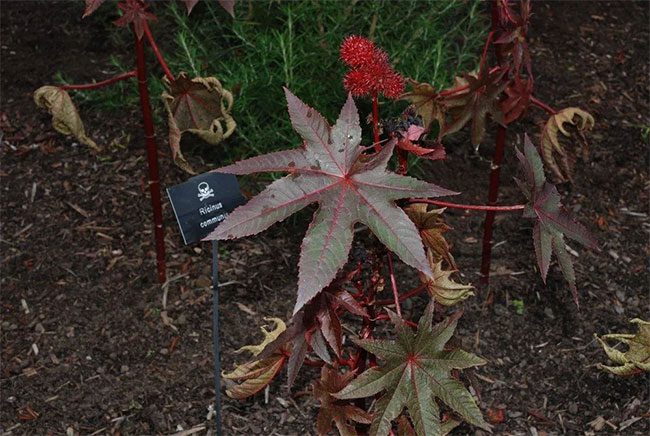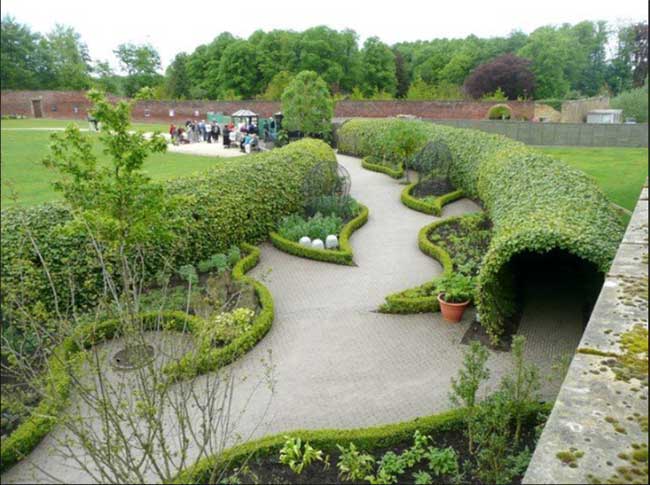If you accidentally wander into this garden, you could find yourself in danger at any moment. So, what lies within?
The Poison Garden in Northumberland, England, is home to over 100 types of toxic, hallucinogenic, and narcotic plants. And it is currently open to the public.
On the black iron gate leading into the garden, the inscription reads, “These plants can kill”, accompanied by a skull and crossbones symbol. This warning is no joke – the land behind this gate is the deadliest garden in the world.

The entrance to the deadliest garden in the world.
The garden originated from the idea of the first Duke of Northumberland in 1750. The third Duke collected seeds from around the world to expand the garden.
By the time of the fourth Duke, the garden had evolved into a grand Italian-style greenhouse. Later, in the late 19th century, it was redesigned to be larger, featuring more hedges and colorful flower fields. However, after World War II, the garden fell into neglect due to the war.
In 1995, Lady Jane, the 12th Duchess of Northumberland, decided to redesign it after visiting the Medicis’ Poison Garden in Italy. She designed the garden to include various medicinal plants to educate children. However, this idea quickly failed as the simple herbs did not capture the children’s attention.
As a result, in 2005, the Duchess collected over 100 toxic plants to cultivate in the garden. The total cost for designing and developing the garden reached £42 million. Since then, the Alnwick Poison Garden has attracted over 800,000 visitors annually.
The Poison Garden at Alnwick in Northumberland, England is home to over 100 types of toxic, narcotic, and hallucinogenic plants. “Before entering, each visitor is briefed on safety. They are not allowed to touch, taste, or smell anything – however, as noted on our website, occasional visitors have fainted from inhaling toxic gases,” Dean Smith, a guide at the Poison Garden, explained.

Castor Bean – the most toxic plant in the world
One of the dangerous plants grown here is the monkshood, or wolf’s bane, which contains aconitine – a neurotoxin and cardiotoxin. But that is not even the worst of it. “Perhaps the most toxic plant we have here is the Ricinus, or castor bean plant. The Guinness World Records considers it the most toxic plant in the world,” Mr. Smith remarked.
Surprisingly, many of the plants in the garden are quite common. “Many of the plants here grow wild in England, and most of them are alarmingly easy to cultivate,” Mr. Smith noted. Even popular garden shrubs like rhododendrons are present. If their leaves are ingested, the grayanotoxin inside will attack your nervous system. “But you wouldn’t be able to eat the leaves because they taste terrible,” he reassured.
Then there’s the Laburnum, the second most toxic plant in England (after the yew). Many people plant them around their homes for their beautiful yellow flowers, but they contain a toxin called cytisine. “This plant is so toxic that if a branch falls to the ground and a dog picks it up months later, there’s a high chance that dog won’t survive,” Mr. Smith explained.

The Alnwick Garden houses over 100 toxic plants. (Photo: CNN)
However, the plants here do not direct their toxins solely at humans and animals. As Mr. Smith explained, if enough rhododendrons grow close together, they will poison the soil – making it so that the only plant that can thrive is the rhododendron. Furthermore, if bees only collect nectar from rhododendrons, the liquid will turn red and, in small doses, have hallucinogenic properties. “But larger doses can be fatal,” he warned.
Some plants can kill even without being eaten, touched, or smelled. There is one type of plant in the garden that can kill you just by pruning it. The leaves of the Prunus laurocerasus (commonly known as cherry laurel) contain two components, cyanogenic glycoside and cyanide ions. While these components are harmless on their own, cutting the leaves with a knife can release cyanide gas – a deadly poison.
Hellebores are another common hazardous plant found here. The roots contain toxins that can stop your heart, and the sap is a strong skin irritant. Therefore, always wear gloves, Mr. Smith warns, and do not remove them with your teeth. That is a strict no-no that the gardeners here will never do. Mr. Robert Ternent, who oversees the gardening staff, states that the staff must follow several safety protocols. “When handling giant hogweed, you must be fully equipped: protective clothing along with a mask and gloves,” Mr. Smith emphasized.
However, Ms. Amy Thorp, a gardener, does not feel fearful. “I believe these plants were here before we arrived. So, we should learn about their uses. Not all of them are bad; many plants here are used for good purposes,” she stated.
In fact, some plants here are excellent medicinal herbs, such as the yew, which is used in breast cancer treatment. And the periwinkle is also a “double-edged sword”: its components can be lethal, but if processed correctly, they can produce beneficial medicines.
It is no surprise that the garden is part of a drug education program. As Ms. Claire Mitchell, the community and education leader explains: “Northeast England has the highest drug-related death rate in England and Wales. We need to do something to get information to the young people there. Therefore, the drug education program stems from tours of the Poison Garden, where we have drug plants, and the entire purpose behind it is to prevent their harm.”
Indeed, as Mr. Smith stated, the garden grows “drugs from A to C.” They cultivate opium poppy (a Class A drug), cannabis (Class B), and Catha edulis, commonly known as “khat” (Class C). However, visitors should not entertain any ideas of stealing. According to Mr. Ternent, the staff at the Poison Garden are legally required to supervise meticulously, count, and record reports on their drug plants – and then submit evidence that they have destroyed them at the end of each season.


















































